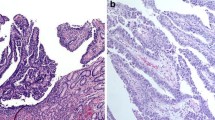Abstract
Purpose
To explore the clinicopathological features and prognosis of papillary gastric adenocarcinoma (PGC).
Methods
The subjects of this retrospective analysis were 1525 patients with gastric cancer in a single center in China.
Results
The patients with PGC were generally of advanced age and the tumor was located in the upper 1/3 of the stomach. PGC was well or moderately differentiated, with serosal infiltration, early lymph node metastasis, TNM stages I/II, liver metastasis, and a short postoperative overall survival time. Patients with the secondary pathological type of papillary adenocarcinoma presented with clinicopathological similarities to those with primary PGC. PGC was a risk factor for poor survival in both univariate and multivariate analyses.
Conclusion
Papillary gastric adenocarcinoma (PGC) showed different clinicopathological characteristics and prognosis to other types of gastric cancer (GC), even if it was not the primary pathological type. The higher the proportion of papillary adenocarcinoma in gastric cancer samples, the shorter the postoperative survival time of patients. PGC needs further multicenter studies.




Similar content being viewed by others
References
Yasuda K, Adachi Y, Shiraishi N, Maeo S, Kitano S. Papillary adenocarcinoma of the stomach. Gastric Cancer. 2000;3(1):33–8.
Hu B, El Hajj N, Sittler S, Lammert N, Barnes R, Meloni-Ehrig A. Gastric cancer: classification, histology and application of molecular pathology. J Gastrointest Oncol. 2012;3(3):251–61.
Sitarz R, Skierucha M, Mielko J, Offerhaus GJA, Maciejewski R, Polkowski WP. Gastric cancer: epidemiology, prevention, classification, and treatment. Cancer Manag Res. 2018;10:239–48.
Zhang W, Cui C, Wang J. Gastric cancer in young patients-an analysis of 142 cases. Chin J Med Guide. 2015;4:325–7.
Leung WK, Wu M-S, Kakugawa Y, Kim JJ, Yeoh K-G, Goh KL, et al. Screening for gastric cancer in Asia: current evidence and practice. Lancet Oncol. 2008;9(3):279–87.
Yu Y, Zhu Z. The interpretation of WHO classification of tumors of the digestive system (2010 edition) (in Chinese). J Surg Concepts Pract. 2011;5:508–12.
Bosman FT, Carneiro F, Hruban RH, Theise ND. WHO classification of tumours of the digestive system. WHO classification of tumors of the digestive system. 2010.
Association JGC. Japanese classification of gastric carcinoma: 3rd English edition. Gastric Cancer. Kanagawa: Association JGC; 2011.
Uesugi N, Sugai T, Sugimoto R, Eizuka M, Fujita Y, Sato A, et al. Clinicopathological and molecular stability and methylation analyses of gastric papillary adenocarcinoma. Pathology. 2017;49(6):596–603.
Uefuji K, Ichikura T, Tamakuma S. Clinical and prognostic characteristics of papillary clear carcinoma of stomach. Surg Today. 1996;26(3):158–63.
Eom DW, Kang GH, Han SH, Cheon GJ, Han KH, Oh HS, et al. Gastric micropapillary carcinoma. Am J Surg Pathol. 2011;35(1):84–91.
Min BH, Byeon SJ, Lee JH, Kim KM, An JY, Choi MG, et al. Lymphovascular invasion and lymph node metastasis rates in papillary adenocarcinoma of the stomach: implications for endoscopic resection. Gastric Cancer. 2018;21(4):680–8.
Maehara Y. Pertinent risk factors and gastric carcinoma with synchronous peritoneal dissemination or liver metastasis. Surgery. 1991;5(110):820–3.
Kaibara N, Kimura O, Nishidoi H, Makino M, Kawasumi H, Koga S. High incidence of liver metastasis in gastric cancer with medullary growth pattern. J Surg Oncol. 1985;28(3):195–8.
Ye X. Correlation analysis on gastric cancer pathological ty** and prognosis. Int Med Health Guidance News. 2012;18(20):3009–11.
Lee HJ, Kim GH, Park DY, Kim YK, Jeon HK, Lee BE, et al. Endoscopic submucosal dissection for papillary adenocarcinoma of the stomach: is it really safe? Gastric Cancer. 2017;20(6):978–86.
Sekiguchi M, Kushima R, Oda I, Suzuki H, Taniguchi H, Sekine S, et al. Clinical significance of a papillary adenocarcinoma component in early gastric cancer: a single-center retrospective analysis of 628 surgically resected early gastric cancers. J Gastroenterol. 2015;50(4):424–34.
Yu Y. Evaluation of traditional pathological classification at molecular classification era for gastric cancer. Chin J Gastrointes Surg. 2014;17(1):18–20.
Cui J, Liang H, Deng J, Ding X, Pan Y, Zhang L, et al. Clinical significance of Lauren ty** in the prognosis evaluation of gastric cancer. Chin J Dig. 2014;34(7):449–52.
Yu H, Fang C, Chen L, Shi J, Fan X, Zou X, et al. Worse prognosis in papillary, compared to tubular, early gastric carcinoma. J Cancer. 2017;8(1):117–23.
Nakashima Y, Yao T, Hirahashi M, Aishima S, Kakeji Y, Maehara Y, et al. Nuclear atypia grading score is a useful prognostic factor in papillary gastric adenocarcinoma. Histopathology. 2011;59(5):841–9.
Zhang Q, Ming J, Zhang S, Li B, Yin L, Qiu X. Micropapillary component in gastric adenocarcinoma: an aggressive variant associated with poor prognosis. Gastric Cancer. 2015;18(1):93–9.
Acknowledgements
This study was supported in part by grants from the Programs of National Natural Science Foundation of China (No. 81572372), National Key Research and Development Program of China (2016YFC1303202), and National Precision Medicine Research Program (2017YFC0908300).
Author information
Authors and Affiliations
Corresponding authors
Ethics declarations
Conflict of interest
We have no conflicts of interest to declare.
Ethical standards
All authors are accountable for all aspects of the work. Informed consent for inclusion in the study was obtained from all patients. All procedures performed in studies involving human participants were in accordance with the ethical standards of the institutional and/or national research committee and with the 1964 Helsinki Declaration and its later amendments or comparable ethical standards.
Additional information
Publisher's Note
Springer Nature remains neutral with regard to jurisdictional claims in published maps and institutional affiliations.
Rights and permissions
About this article
Cite this article
Wang, X., Deng, J. & Liang, H. Well differentiated carcinoma with a poor prognosis: a retrospective analysis of papillary gastric adenocarcinoma. Surg Today 51, 1387–1396 (2021). https://doi.org/10.1007/s00595-021-02289-3
Received:
Accepted:
Published:
Issue Date:
DOI: https://doi.org/10.1007/s00595-021-02289-3




